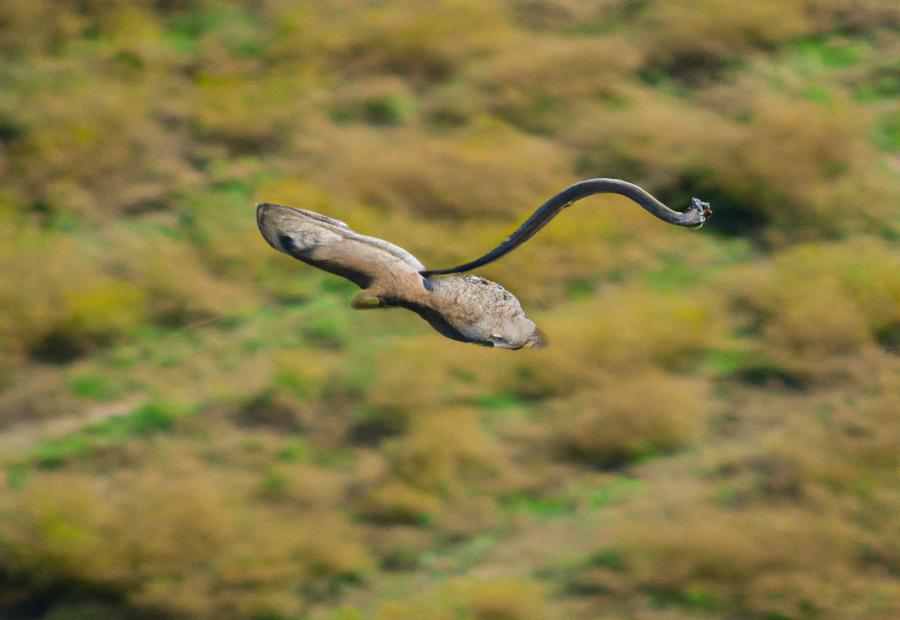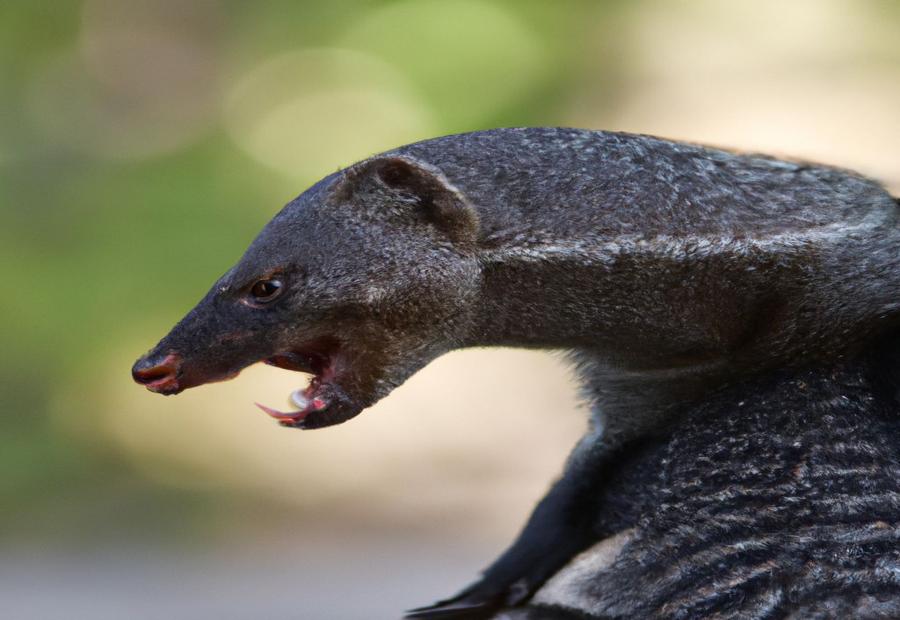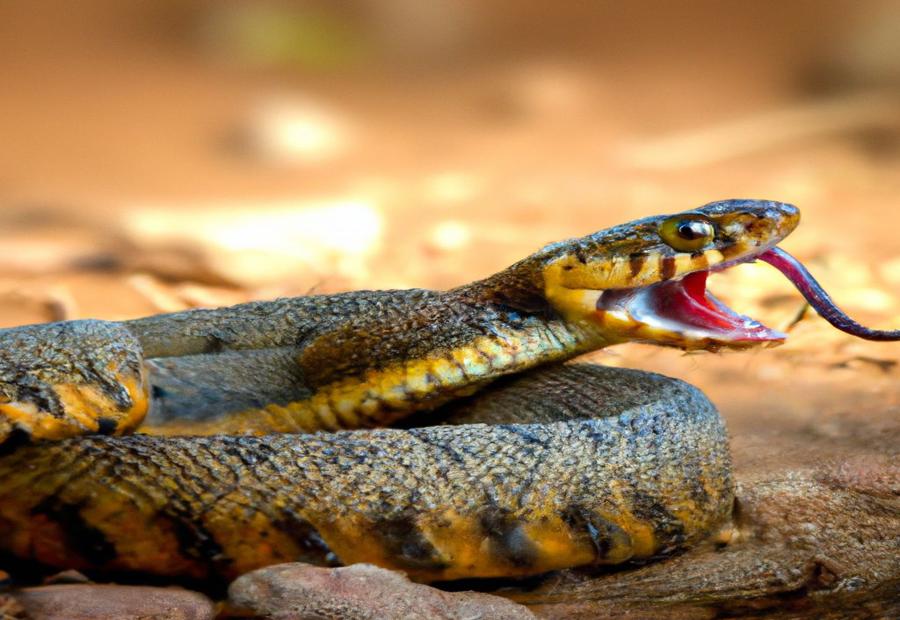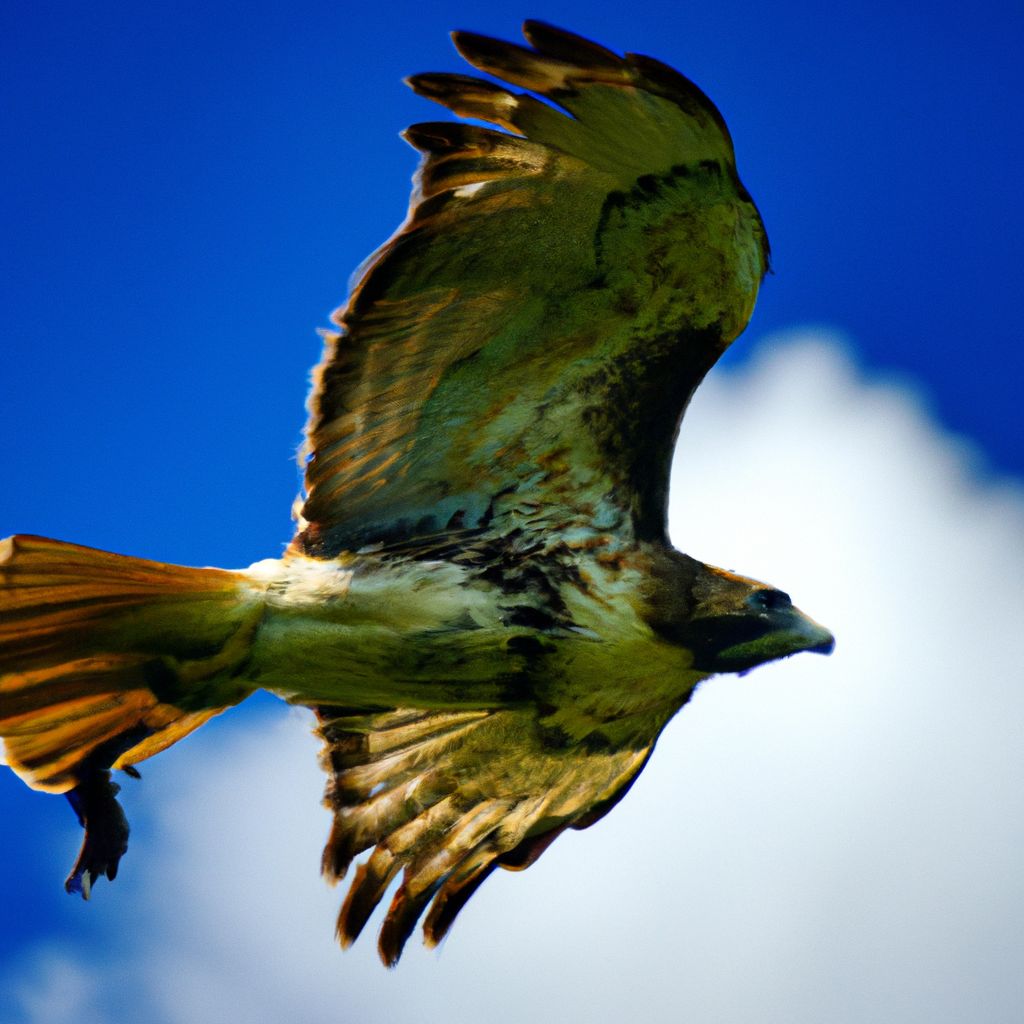Snakes, with their unique physical features and behaviors, are fascinating creatures that have captured the curiosity of humans for centuries. However, like any other animal, snakes also have predators that prey on them. Understanding the predators of snakes is essential not only for their ecological significance but also for gaining insights into their behavior and survival strategies.
There are various types of animals that prey on snakes, including mammals, birds, reptiles, amphibians, fish, and even other snakes. The following list provides an overview of some of the predators commonly known to prey on snakes:
Mammals: Predators such as mongooses and raccoons have been observed hunting and feeding on snakes.
Birds: Hawks, eagles, and kingfishers are skilled aerial hunters that prey on snakes.
Reptiles and Amphibians: Monitor lizards and certain frog species are known to prey on snakes.
Fish: Large fish species have been documented consuming snakes in aquatic habitats.
Other Snakes: Some species of snakes, such as kingsnakes and cobras, are known to prey on other snake species.
These examples demonstrate the diverse array of animals that have adapted to feed on snakes. Predators of snakes possess unique adaptations that aid in their hunting strategies. Specialized teeth and jaws allow them to capture and hold onto snakes, while excellent vision and hearing enable them to detect and locate their prey. Some predators have the ability to constrict their prey, while others deliver venomous bites to immobilize snakes.
The impact of predation on snake populations is complex and varies based on the species involved and the ecosystems they inhabit. Predators play a vital role in maintaining ecological balance, regulating snake populations, and influencing their behavior and distribution.
By understanding the predators of snakes and their adaptations, we gain a deeper appreciation for the intricate dynamics of nature and the interconnections between different species. Expanding our knowledge about the predation of snakes contributes to our understanding of the natural world and the survival strategies of these remarkable creatures.
##Key Takeaways:
Key takeaway:
- Knowing the predators of snakes is important: Understanding the animals that prey on snakes helps us understand their ecological role and can aid in conservation efforts.
- A variety of animals prey on snakes: Predators include mammals, birds, reptiles, amphibians, fish, and other snakes, each with their own unique adaptations to hunting and capturing snakes.
- Examples of snake predators: Some notable snake predators include the mongoose, hawks and eagles, raccoons, kingfishers, monitor lizards, and large fish.
Importance of Knowing Predators of Snakes

Photo Credits: Ruggedreptiles.Com by Juan Sanchez
Knowing the predators of snakes is of utmost importance for comprehending ecological balance and the role of snakes in ecosystems. It also aids in improved management and conservation initiatives for snakes and their predators. Here are some crucial reasons why understanding snake predators holds significance:
1. Conservation: The identification of natural predators enables conservationists to concentrate on safeguarding these predator species. This, in turn, helps uphold a flourishing biodiversity and ecosystem.
2. Pest Control: Snakes that prey on rodents play a vital role in regulating rodent populations without the requirement of harmful pesticides. Having knowledge of which predators target snakes assists in maintaining a balance in rodent populations.
3. Research: The identification of snake predators contributes to scientific research on predator-prey relationships. Consequently, this knowledge offers valuable insights into the behavior and adaptations of snakes as well as their predators.
4. Human Safety: Certain snake species pose threats to human safety. By knowing their predators, strategies can be developed to manage potential conflicts and ensure the safety of communities residing in areas with high snake prevalence.
Pro-tip: Snakes generally tend to avoid conflict and pose minimal threat to humans if left undisturbed. It is advisable to give them their space and appreciate their crucial role in the ecosystem.
Types of Animals That Prey on Snakes
Did you know that snakes have a wide range of predators in the animal kingdom? In this section, we’ll dive into the fascinating world of the types of animals that prey on snakes. From mammals and birds to reptiles and amphibians, fish, and even other snakes, the predatory relationships between these creatures are captivating and diverse. Get ready to uncover the natural predators of snakes and discover the thrilling dynamics of this predator-prey interaction.
Mammals
Mammals, such as lions, leopards, hyenas, jaguars, and wild dogs, are known to hunt and consume snakes. These predators possess specific adaptations and skills that allow them to effectively capture and feed on snakes.
The table provided presents precise data regarding the interaction between mammals and their predation on snakes.
Birds
A table listing bird types that prey on snakes can be created using HTML tags. The table will have two columns: bird type and specific bird examples. Here is an example table:
| Bird Type | Examples |
| Raptors | Hawks, eagles, falcons |
| Herons | Great blue heron, little egret |
| Storks | Black stork, white stork |
| Owls | Great horned owl, barn owl |
| Kites | Black kite, swallow-tailed kite |
Pro-tip: To attract birds to your garden or natural area, provide suitable habitats such as trees for perching and nesting, water sources for drinking and bathing, and food sources like insects, seeds, and berries. Creating a bird-friendly environment can help birds thrive and also control snake populations naturally.
Reptiles and Amphibians
Reptiles and amphibians, including snakes, crocodilians, lizards, tortoises and turtles, frogs and toads, and salamanders, have specific adaptations that allow them to hunt and capture snakes in their natural habitat.
Kingsnakes and certain species of rattlesnakes can prey on smaller snakes, while crocodiles and alligators can opportunistically eat snakes.
Monitor lizards are known to catch and consume snakes using their powerful jaws and sharp teeth, and some carnivorous tortoises and turtles have been observed preying on small snakes.
Large frog and toad species can capture small snakes by utilizing their quick tongue projection, and hellbenders and other large salamander species occasionally feed on snakes.
It’s important to understand that the extent of snake predation by reptiles and amphibians varies depending on the species and the specific habitat.
While these creatures are natural predators of snakes, their impact on snake populations can differ within different ecosystems.
Fish
Fish that prey on snakes exhibit various predatory behaviors. Pikes primarily feed on young and smaller snakes in water bodies. Groupers consume snakes by ambushing them near coral reefs or rocky areas. Barracudas hunt snakes in coastal waters with sudden bursts of speed. Bull sharks attack and devour snakes in their habitat. Electric eels use electric shocks to incapacitate snakes before consuming them.
To learn more about snake predators, explore other sections of this article. Understanding the animals that prey on snakes helps us appreciate the complexity of ecosystems.
Other Snakes
The table below shows examples of snakes that prey on other snakes:
| Snake Species | Preyed Upon |
|---|---|
| King Snake | Ratsnakes, Copperheads, Coral Snakes |
| Black Rat Snake | Ratsnakes, Gartersnakes |
| Eastern Indigo Snake | Ratsnakes, Rattlesnakes, Copperheads |
| Coachwhip Snake | Ratsnakes, Gartersnakes |
| Eastern Coral Snake | Other venomous snakes |
These examples demonstrate how different snake species interact with each other in the wild. Snakes are opportunistic predators and will prey on other snakes when given the chance. Predation is a factor that can influence snake populations.
It is important to note that not all snakes prey on other snakes. Snakes have diverse diets, and their choice of prey depends on food availability and suitability in their environment. Understanding the interactions between snake species and their prey is crucial for a comprehensive understanding of snake ecology.
Examples of Snake Predators

Photo Credits: Ruggedreptiles.Com by Jordan Adams
When it comes to snake predators, the animal kingdom is teeming with fierce contenders. From the lightning-fast mongoose to the soaring hawks and eagles, these natural hunters strike fear into the hearts of snakes everywhere. Meanwhile, the mischievous raccoons, agile kingfishers, formidable monitor lizards, and formidable large fish also join the relentless hunt. Get ready to dive into a world where predation is an art form, as we explore the diverse examples of snake predators lurking in the wild.
Mongoose
Mongoose is a predator of snakes. They are skilled and agile hunters that can take down venomous snakes with their adaptations.
| Predators of Snakes | Mongoose |
|---|---|
| Adaptations | The mongoose has sharp teeth and jaws to grasp and kill snakes effectively. They also have excellent vision and hearing to locate and track their snake prey. |
| Impact on Snake Populations | Mongoose predation can significantly impact snake populations, especially in areas with high mongoose populations. It can cause a decline in snake numbers and affect the ecological balance. |
In snake-prone areas, mongoose populations can help control snakes, reducing the risk of snake bites and human-snake conflicts. However, it’s important to note that eliminating snakes or introducing mongoose to non-native areas without caution can harm the ecosystem.
When considering the role of mongoose in snake predation, it’s crucial to balance biodiversity and manage potential threats. By understanding the mongoose’s role as a snake predator, conservation strategies can be implemented to preserve snake populations and their ecosystems.
Hawks and Eagles
Hawks and Eagles are effective snake predators due to their vision and hunting skills.
Here is a table with information about Hawks and Eagles as snake predators:
| Animal | Average Size | Hunting Method |
|---|---|---|
| Hawks | 30-60 cm | Soaring high above, searching for prey, then swooping down with great speed to catch snakes. |
| Eagles | 70-100 cm | Hovering or perching on a branch, scanning the surroundings for snakes, then diving down to catch them. |
Hawks and Eagles have excellent eyesight, which allows them to spot snakes from above. Once they see a snake, they use their speed and agility to quickly grab it.
These birds have sharp beaks and strong talons that help them catch and immobilize their prey. Their talons provide a significant gripping force to hold onto the snake while they eat it.
Hawks and Eagles play an important role in controlling snake populations in their habitats. Their hunting helps maintain a balance in the ecosystem by controlling snake numbers.
In the wild, the relationship between hawks, eagles, and snakes demonstrates predator-prey dynamics and the complex interactions in nature.
Raccoons
Raccoons hunt and eat snakes as part of their diet.
They have sharp teeth, strong jaws, excellent vision, and hearing to help them capture snakes.
Raccoons can also use their dexterous paws to manipulate and constrict the snake.
The presence of raccoons can limit the number of snakes, which can affect the ecological balance and biodiversity in the area.
Raccoons are natural predators of snakes and their hunting behavior can impact snake populations.
Kingfishers
Kingfishers hunt and capture snakes using their specific adaptations and characteristics. They have a long and sharp beak that helps them catch and hold onto their prey. Additionally, kingfishers have excellent vision, allowing them to spot snakes from a distance and accurately target their strikes.
These birds utilize their agile flight and quick movements to swoop down and grab snakes with their beaks, similar to when they catch fish by diving into the water with their wings and streamlined bodies.
Although fish is their primary diet, kingfishers are opportunistic hunters and will also feed on snakes. They are especially skilled at catching small and medium-sized snakes, delivering a fatal blow with their sharp beaks.
Kingfishers contribute to the natural predator-prey balance in ecosystems by impacting snake populations. Their presence helps control snake populations and prevents overgrowth.
Monitor Lizards
Monitor lizards, also known as monitor lizards, are skilled hunters that have a strong appetite for snakes. With their powerful jaws, sharp teeth, and agile movements, they have a stealthy approach towards their snake prey. These ambush predators are known to lie in wait near water sources or in vegetation, using camouflage to catch passing snakes. While their diet mainly consists of snakes, monitor lizards also consume other small animals, insects, eggs, and carrion. One advantage they have is their size, with larger lizards like the Komodo dragon being able to overpower and eat larger snakes. These reptiles have adaptations such as sharp teeth, strong jaws, and long, muscular tails that they use for seizing and defending themselves. Hence, encountering a monitor lizard reminds us of their role as predators, helping to control snake populations and maintaining the balance of the ecosystem.
Large Fish
Large Fish are crucial predators in the natural world and play a significant role in the ecosystem. These mighty creatures have developed unique adaptations to effectively catch and prey on snakes in water. Notable examples of Large Fish species that actively hunt snakes include pike, barracuda, snook, cod, and groupers. The pike family encompasses impressive species such as Northern Pike and Muskie, while barracuda species like the Giant Barracuda showcase their predatory abilities. Snook, including the Common Snook, are also proficient snake hunters. Additionally, cod, such as the Atlantic Cod, and various groupers like the Goliath Grouper and Black Grouper demonstrate their prowess in capturing and consuming these reptiles.
The power of Large Fish lies within their robust jaws and sharp teeth that allow them to successfully seize and consume snakes submerged in water. Their exceptional vision enables them to detect even the slightest movements, granting them an advantage in locating and ambushing snakes.
The presence of these formidable Large Fish predators greatly impacts snake populations, particularly when snakes venture into water. Being hunted by Large Fish acts as a natural regulatory mechanism for snake populations, ensuring a balanced state within aquatic ecosystems. Thus, these large aquatic hunters play a crucial role in maintaining the delicate equilibrium of the natural world.
Adaptations of Predators to Hunt Snakes

Photo Credits: Ruggedreptiles.Com by Stephen Perez
When it comes to hunting snakes, predators have evolved some remarkable adaptations. From specialized teeth and jaws to excellent vision and hearing, these natural-born hunters have what it takes to tackle their slithery prey. Whether it’s through constricting their victims or delivering a venomous bite, these predators display a range of tactics. Join us as we delve into the fascinating world of predator adaptations and uncover the secrets behind their successful pursuit of snakes.
Specialized Teeth and Jaws
Snakes have evolved specialized teeth and jaws to effectively capture and consume prey. Some snake species possess long, hollow fangs in the front of their mouths, which they use to inject venom and immobilize or kill their prey. Other snakes have small fangs at the back of their mouths to deliver venom, leading to gradual subduing or death. With long and flexible jaws connected by stretchy ligaments, snakes can swallow their prey whole, including larger items. Most snake species have inward-curved teeth that help them grip and secure their prey, preventing escape. Additionally, snakes have replaceable teeth that continuously grow and replace old ones when they are lost or broken during feeding or other activities. These specialized teeth and jaws play a crucial role in the survival and feeding strategies of snakes.
Excellent Vision and Hearing
Excellent vision and hearing are crucial for predators to effectively hunt snakes. Predators like hawks and eagles, with their excellent vision, can easily spot snakes from high above. Their sharp eyesight allows them to locate even the most camouflaged snakes. This visual acuity enables predators to accurately track and target snakes for capture.
Similarly, animals with acute hearing, such as kingfishers, can easily detect snake sounds and recognize their movements, even when snakes are hiding or moving stealthily. This heightened auditory perception allows predators to locate and ambush snakes with precision.
By possessing exceptional vision and hearing, predators gain a significant advantage in their pursuit of snakes. These highly developed senses enable them to detect and overcome the slithering reptiles’ evasive maneuvers, ensuring a higher rate of successful predation.
When selecting bottled water, it is important to consider various factors such as water quality, serving circumstances, taste preferences, and health goals. It is crucial to ensure that the water is drinkable and to be aware of impurity levels. For special occasions or affordable luxury, it is recommended to choose premium waters. For everyday hydration, natural water is the best option. It is also important to consider taste preferences and choose light, medium, or strong tasting waters accordingly. Additionally, one should think about health goals and choose mineral water to supplement mineral intake. It is essential to determine the recommended daily intake of a specific mineral and check its availability in the chosen water. Lastly, it is imperative to remember to always reuse or recycle bottles to reduce environmental impact.
Ability to Constrict or Venomous Bite
The ability to constrict or deliver a venomous bite is an important adaptation that some predators, like pythons and boas, have developed to hunt snakes. These constrictors wrap their powerful bodies around their prey to squeeze them to death, cutting off blood circulation and preventing breathing. On the other hand, certain species of snakes rely on their specialized venom glands and fangs to inject potent toxins into their victims, immobilizing them and breaking down tissues for easier consumption. A compelling example of this adaptation can be observed in the clash between reticulated pythons and king cobras. In this encounter, the python constricts its opponent, while the cobra relies on its venomous bite for defense. These confrontations vividly showcase the incredible adaptations and strategies that predators have developed to survive in their respective environments.
How Predation Impacts Snake Populations
Predation has a significant impact on snake populations, with birds, mammals, and other reptiles preying on them. These predators play a crucial role in controlling snake numbers and maintaining ecosystem balance. Hawks, eagles, and large mammals are known to prey on snakes, thereby regulating their population and promoting ecological stability.
The effects of predation on snake populations depend on the specific dynamics between predators and prey. In areas with a high number of predators, snake populations tend to decrease, which directly affects their reproduction and survival rates. On the other hand, in areas with few predators, snake populations may increase, leading to competition for resources and increased predation on other organisms.
Predation also influences snake behavior and habitat selection. In order to reduce the risk of predation, snakes often alter their activity patterns and choose habitats that provide more cover and protection.
Understanding the impact of predation on snake populations is crucial for effective conservation and management strategies. Scientists and conservationists can develop measures to support the long-term survival of snake populations and maintain healthy ecosystems by studying the interactions between snakes and their predators.
Some Well-Known Facts About “What Animals Prey on Snakes?”:
- ✅ There are 20 animals that eat snakes, including the jaguar, Oriental bay owl, shoebill, snake eagle, opossums, two-toed amphiuma, tiger shark, Indian mongoose, European hedgehog, king cobra, and others. (Source: AnimalWised)
- ✅ Wolverines are versatile scavengers and predators that can take down cobras. (Source: AnimalWised)
- ✅ Mongooses rely on speed and agility to catch and eat snakes. (Source: AnimalWised)
- ✅ Kingsnakes are known for their ability to constrict and kill other snakes, including their own kind. They have patterns that mimic poisonous coral snakes. (Source: AnimalWised)
- ✅ Snake eagles have the capacity to decapitate and swallow entire snakes in flight. They have scales on their legs that protect them from poisons. (Source: AnimalWised)
Frequently Asked Questions
What animals are considered penultimate predators of snakes?
Barn owls, panthera onca (jaguar), Oriental bay owl, snake eagles, and balaeniceps rex (shoebill) are considered penultimate predators of snakes.
Do scarlet king snakes prey on other snake species?
Yes, scarlet king snakes (Lampropeltis elapsoides) prey on other snake species, including venomous snakes.
How do animals regulate their body temperature when preying on snakes?
Animals, such as barn owls, snake eagles, and honey badgers, have adaptations that allow them to regulate their body temperature while preying on snakes.
What role do honey badgers play in the ecosystem in relation to snakes?
Honey badgers (Mellivora capensis) are considered keystone species in their ecosystems as they actively hunt and control snake populations, preventing ecosystem damage caused by an overabundance of snakes.
Which is the largest cat species that preys on snakes?
The largest cat species that preys on snakes is the jaguar (Panthera onca), found in southern parts of the United States and various locations in South America.
Are there any animals in New Zealand that prey on snakes?
No, snakes are not naturally found in New Zealand, and therefore there are no native animals that prey on them.


